Anole Lizard
There are just under 400 species, several of which change color.
Advertisement
Anole Lizard Scientific Classification
Read our Complete Guide to Classification of Animals.
Anole Lizard Conservation Status
Anole Lizard Facts
- Prey
- Insects
- Name Of Young
- hatchlings
- Fun Fact
- There are just under 400 species, several of which change color.
- Biggest Threat
- Other reptiles
- Most Distinctive Feature
- On most species, the brightly colored dewlap on the neck of the males
- Other Name(s)
- American green anole, Carolina green anole, American anole, Carolina anole, North American green anole, red-throated anole, American Chameleon
- Litter Size
- 1 - 2 eggs
View all of the Anole Lizard images!
The name Anole Lizard refers to one of over 400 species of mostly color-changing lizards located primarily in South and Central America.
One of the most charming residents of the North American garden is the little green anole lizard. Curious and occasionally friendly, these bright green reptiles can be seen darting across deck rails and rearing their heads above flower pots. They hunt for moths among begonias and take flies for a snack with lightning-quick precision.

There is a single species, the Green Anole, Anolis carolinensis, native to North America, which is sometimes called the American Chameleon. Though many anole lizards can exhibit color adaptations to their environment, the anole lizard differs from true Chameleons in many ways, not least in their very limited ability for color change. In most species, the male and female differ, most commonly because the males have a brightly colored dewlap on the necks, but males and females may also be characterized by size and sometimes nose length. Another species, the Brown Anole (A. sagrei), can be found in parts of the United States, but is considered an invasive species and has a negative effect on local ecosystems. A few other species, including the Knight Anole (A. equestris) are also found in Florida but are introduced species and not native to the area.
Facts About Anole Lizards
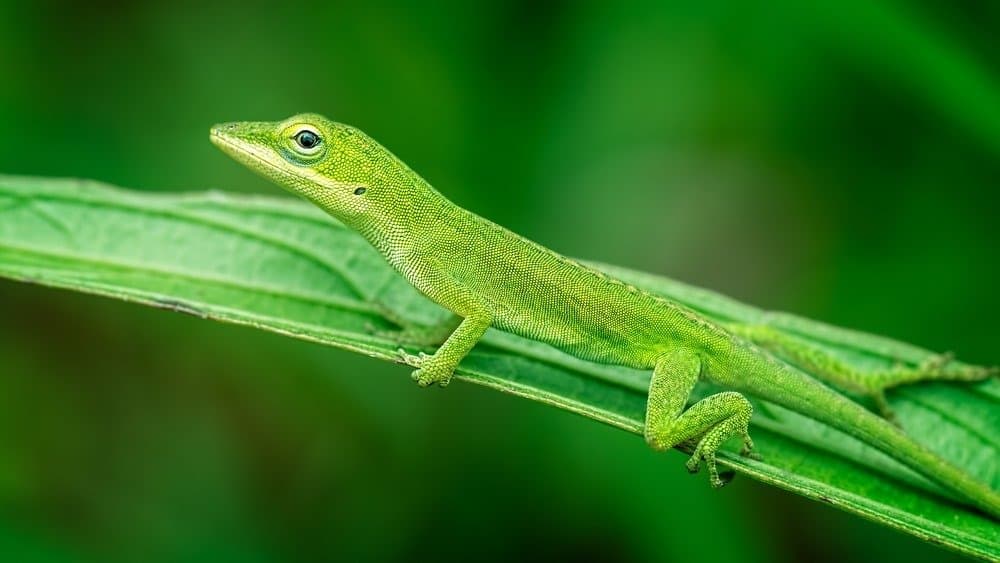
Green Anole lizards can change colors from green to brown.
©Brad Boland/Shutterstock.com
- Most anole species can change color to some degree.
- Most anole males have a brightly colored dewlap, which is used for mating and also marking territory.
- There are around 400 species of anole, with about 150 of those found in the islands of the Caribbean.
- Some anole lizard species can reach up to 20 inches long.
- The males and females of the anole species almost always differ in appearance in some way, including but not limited to the existence of the male’s dewlap.
Species
Anoles come from the family Dactyloidae under the Class Reptilia. Because there are over 400 species, it would be impossible to list all their scientific names here. Collectively, they are called Anolis. Some of the subspecies are:

Native to Cuba, brown Anoles are an invasive species that can be found in the southern U.S., Hawaii, and California.
©Natalia Kuzmina/Shutterstock.com
- Green Anole, Anolis carolinensis: A tree-dwelling species of anole lizard native to the southeastern United States. Small to medium in size, this lizard can change its color from green to brown.
- Brown Anole, Anolis sagrei: A ground-dwelling species of anole lizard native to Cuba and the Bahamas. It has been widely introduced elsewhere by the exportation of plants containing the eggs of the lizard. Brown anoles can be found in the southern United States, Hawaii, and California. This invasive species outcompetes and consumes native species very quickly, leading to negatively affecting the green anole and relegating it to the treetops.
- Knight Anole, Anolis equiestris: The largest anole, the Knight anole is native to Cuba and can grow up to 20 inches long. Their diet consists of mostly insects and snails but sometimes eat small birds and little lizards.
- Cuban Blue Anole, Anolis caliensis: Another native of Cuba, the Cuban Blue anole can also be found in the Bay Islands, Cayos Cochinos off the mainland of Honduras, and on Half Moon Caye off the mainland of Belize. These lizards reach 3 – 4 inches in length and feed on invertebrates. Preferring life on palm trunks, the Cuban Blue females often lay their eggs together to form a communal nest.
- Horned Anole, Anolis allisoni: Also known as the Pinocchio Lizard, the Horned anole is a small, endangered lizard that can only be found along a small stretch of vegetation along an Ecuadorian highway. These tiny anoles only reach lengths of 2 – 3 inches (excluding tail) with males being slightly larger. The males have a conspicuous proboscis growing from the middle of their snouts that is about 2 cm (0.8 in) in length that is used in courtship displays.
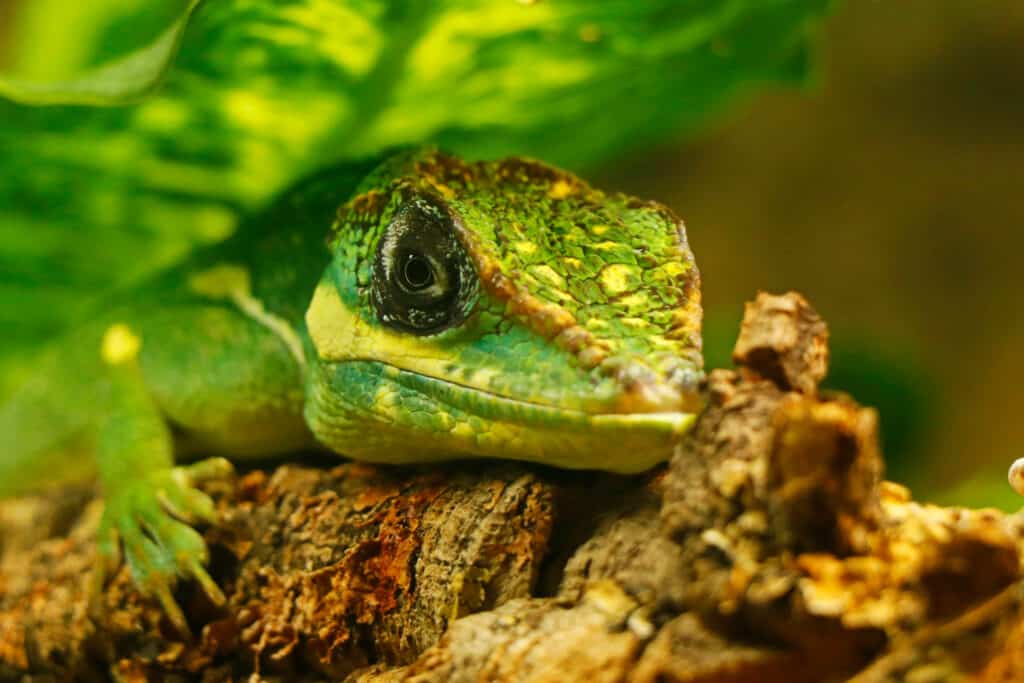
Knight anoles are bold and tend to face any perceived threat rather than back down.
©Libin Jose/Shutterstock.com
Appearance

Most male anole lizards have a colorful dewlap under their necks that is used in courtship.
©Steve Bower/Shutterstock.com
The size and color of each anole lizard species will differ depending on habitat, climate, and diet. Depending on where they live and how they hunt, they may have physical adaptations such as large hind legs for jumping large distances for prey, or short stubby legs if they live higher up in trees and creep up slowly on prey to avoid detection by their predators when hunting. They come in many colors, though the most common colors are a range of greens and browns, with yellow and sometimes blue variations. Most male anole lizards have a dewlap, which is a piece of erectile tissue on the neck, which can be collapsed and extended into a semi-oval shape. The dewlaps of the male can be almost any color, and usually, the color differs greatly from the lizard’s body.
Behavior

Anoles are mostly solitary and docile but will defend their territories.
©Martin Pelanek/Shutterstock.com
Anoles are mostly solitary. They may live near each other but are not generally found in groups. Males aggressively defend their territory during sexual maturity, otherwise, they are typically docile and tolerate humans to varying degrees. Various behavioral adaptations occur depending on the environment in which they live.
Evolution
Ancestors of the green anole lizard hail from Cuba, and long ago spread across the southeastern United States. These little green lizards are now sold in pet stores and have recently become the subjects of several evolutionary scientific studies.
The evolution of animal species is often portrayed as a process that takes place over thousands of years – and that is often the case. But sometimes, as they say, needs must. The North American green anole offers an example of evolution at warp speed. It was a case of evolve or die.
The green anole lizard is the only anole species native to the United States, and for most of their history, they have lived on or around the base of trees where insects abound. Someone brought brown anoles into the country in the 1950s, and those highly invasive lizards quickly began to drive the green anoles from the forest floor to higher branches.
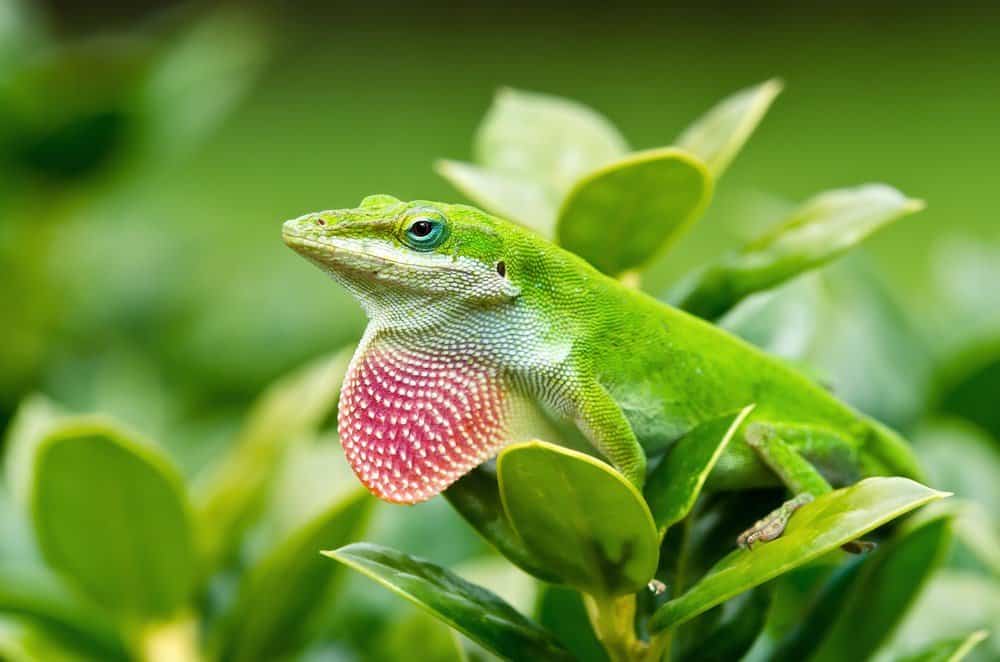
Green Anole lizard (Anolis carolinensis) showing off his bright pink dewlap
©Leena Robinson/Shutterstock.com
Rather than die out, the green anoles forged a new life in the trees and on higher ground. They became expert climbers and found new places to hunt. Amazingly, over a span of a mere 20 generations and 15 years, the green anoles evolved larger toe pads covered with more sticky scales to make climbing easier. According to scientists, this is a perfect example of “character displacement,” an evolutionary process that allows two closely related species to diverge and take advantage of separate niches.
Other studies have proven that the resilient little lizards have evolved to tolerate colder temperatures after surviving extreme cold snaps in some states – while city anoles evolved stickier feet to make climbing up buildings easier. As a species, green anoles have learned to go with the flow to survive.
Habitat

Anoles can be found in many ecosystems – from residential yards, and arid scrub to rainforests.
©Radiant Reptilia/Shutterstock.com
Most anole lizard species live in or near trees, though some live near the base and some prefer the smaller limbs near the top. Their hunting styles will differ depending on their locations. Anole lizards may be found in bushes, reeds, low limbs, tree trunks, and forest canopies. They are found in many ecosystems, including on farms, in residential yards, in rainforests, dry forests, arid scrub, grasslands, and in riverside vegetation.
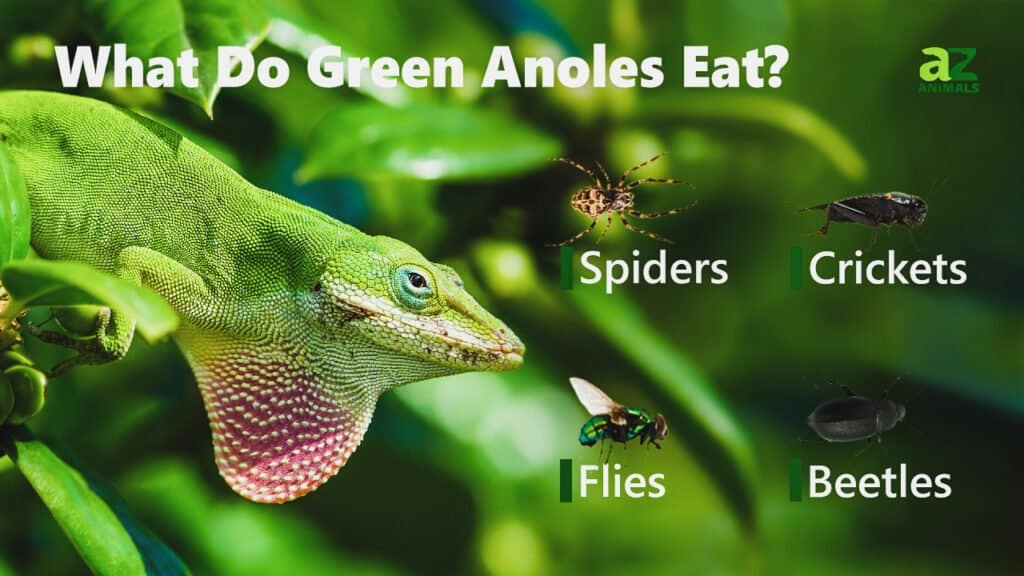
Diet
Almost all anoles are insectivores, though some will also consume some vegetation and nectar. Anoles are hunters who feed primarily on insects, spiders, and other invertebrates, but may also consume nectar, tree sap, and occasionally rotted fruit. Larger species may consume smaller or baby lizards, snakes, and eggs.
Predators and threats
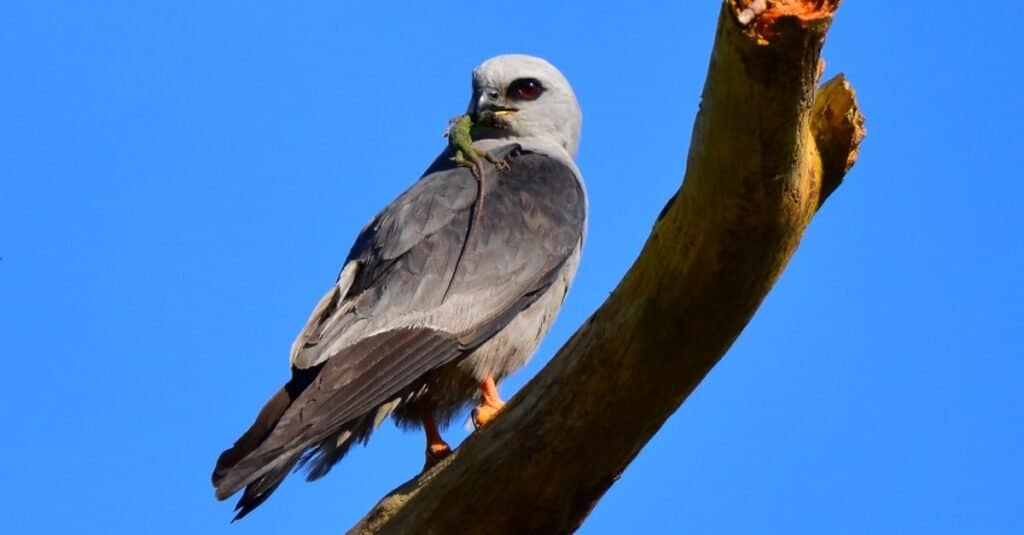
Anoles are prey to birds, snakes, small mammals, and other anoles.
©Chase D’animulls/Shutterstock.com
One threat to anoles is other anoles. For instance, when they share a habitat, Brown Anoles will eat Green Anoles and their eggs. They are also prey for larger reptiles and snakes, as well as many predatory birds and a few small mammals. Their color-changing abilities afford them some protection from predators, but they are vulnerable during mating when they increase their movements and show off brighter colors.
Reproduction and Life Cycle

Male anoles attract females by flexing their dewlaps and doing push-ups.
©Natalia Kuzmina/Shutterstock.com
Typically, when males reach sexual maturity, they will hunt for a mate by flexing their dewlap and sometimes doing what looks like push-ups. These pushups are also used as a show of strength to discourage other males from entering the mating territory. Both males and females are polyamorous, mating with multiple partners over their lifespans. Male anoles defend a singular territory so that they can have exclusive access to females that enter into or live within that territory.
However, the females wander outside the territories and mate with other males also. When a mate is found, the female will lay one or two eggs after copulation, often every day through the mating season. A baby will hatch at about 0.75 inches in size. A baby anole will reach sexual maturity at about 18 months and have a lifespan of two (wild) to seven years (captive).
Population
Populations vary widely between species with Green Anoles being estimated at around 100,000 specimens or more and the Blue Anole so rare that it may be headed for extinction.
View all 194 animals that start with AAnole Lizard FAQs (Frequently Asked Questions)
Are Anole Lizards carnivores, herbivores, or omnivores?
Anoles are primarily insectivores, though they also occasionally consume vegetation and nectar.
Are anole lizards friendly?
Many anole lizards are friendly, many are not. Green Anoles are friendly and are often kept as pets.
Do anole lizards bite?
Yes, anoles can bite, though Green Anoles have tiny teeth and weak jaws.
What do anole lizards eat?
The anole lizard diet consists almost exclusively of insects.
Do anoles lay eggs?
Yes, the female anole lays one to two eggs per day during mating season.
How can you tell if an anole is male or female?
Female anoles are usually smaller in size. The males generally have a brightly-colored dewlap under their necks. The female Green Anole has a white stripe up her back, which the male does not.
Are anole lizards good pets?
Green Anoles are often kept as pets.
How long does an anole lizard live?
In captivity, anoles can live up to seven years, but in the wild, their lifespan is usually only a few years.
Thank you for reading! Have some feedback for us? Contact the AZ Animals editorial team.
Sources
- Current Biology / Accessed February 21, 2022
- The Spruce Pets / Accessed February 21, 2022
- New Floridians / Accessed February 21, 2022
- Wikipedia / Accessed February 21, 2022
- Britannica / Accessed February 21, 2022
- Animal Diversity Web / Accessed February 21, 2022
- Frontiers in Ecology and Evolution / Accessed February 21, 2022
- The Reptile Blog / Accessed February 21, 2022
- Science Daily / Accessed February 21, 2022
- Nature Serve Explorer / Accessed February 21, 2022
- Mongabay / Accessed February 21, 2022


















